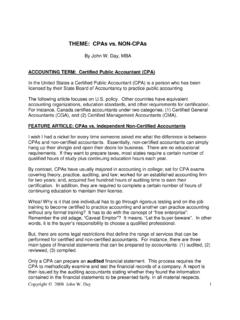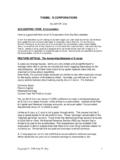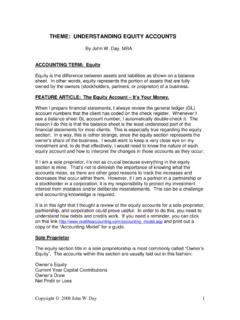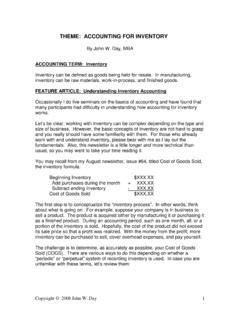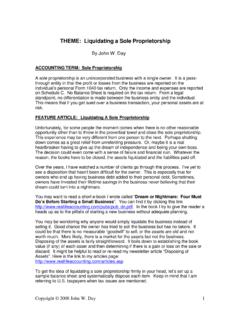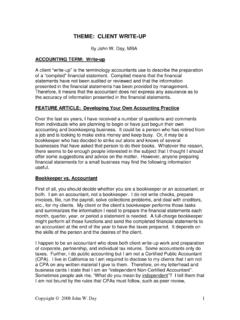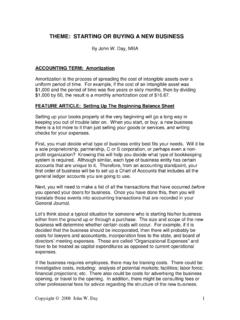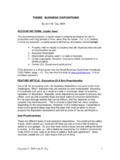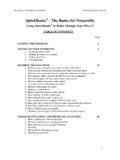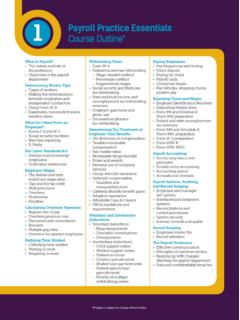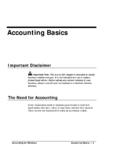Transcription of RLA Article Payroll - Real Life Accounting
1 Copyright 2008 John W. Day 1 THEME: Payroll By John W. Day, MBA Accounting TERM: Payroll Clearing Account A Payroll clearing account is a general ledger account that is normally set up in the asset section of the balance sheet. The purpose it serves is to reconcile all the net Payroll checks paid to employees during an Accounting period with a general journal entry that summarizes the total of all the net Payroll checks. If an discrepancy occurs, the difference will remain in the Payroll clearing account. This difference can then be researched to find the cause of the discrepancy.
2 FEATURE Article : Recording Payroll On Your Books If you are a business owner or manager, chances are you have had to deal with Payroll and all of its complexities. If you haven t dealt with Payroll yet, you may have to in the future. There are many parts to Payroll . First you have to learn how to calculate withholding taxes for employees and understand all the federal and state rules associated with those taxes. If you don t stay on top of the rules, which can change from year to year, you risk miscalculating the taxes and/or missing reporting deadlines. The price for not conforming to the rules can be severe penalties.
3 Faced with these hurdles, many small businesses opt for a Payroll tax service. This is usually a good idea, as these services tend to be inexpensive and can lift a heavy burden from the shoulders of an owner or manager. However, the information provided by the Payroll service company has to be entered into the company s books. There is a simple way and a complicated way to do this, but first, you must have an understanding of what you are trying to accomplish. It is imperative to understand the difference between employee withholding taxes and employer Payroll taxes.
4 In the U. S., it works like this: Employee Taxes Employer Taxes Federal: Federal: FIT (Federal Income Tax) FICA Tax FICA Tax (Social Security) Medicare Tax Medicare Tax FUTA Tax (Federal Unemployment) State: State: SIT (State Income Tax) SUTA Tax (State Unemployment) SDI (State Disability Insurance) The state I use in the examples above is California. However, your state may not Copyright 2008 John W. Day 2 have an income tax, etc. If you live outside the , your country may have similar taxes but they may come under different names.
5 Regardless, you will have to follow the same Accounting procedures. Many of the larger Payroll service companies provide a ton of information in the form of Payroll reports. Unfortunately, the Payroll information you need for your general ledger is not often easily discernable. I have had a Payroll service business in Santa Barbara for 20 years and even I have a hard time deciphering the large Payroll service companies reports. The larger Payroll companies insist that you pay your Payroll taxes the day of Payroll . Therefore, you must set up an agreement between your bank and the Payroll company so that the Payroll company can automatically withdraw funds from your account to their account.
6 They pay the taxing agencies directly. Your taxes may not be due on that exact date, so the Payroll company has use of your money until the time the taxes are paid. They make millions on the interest alone. An advantage of using a smaller Payroll service company or using your own Payroll software program is that you have the use of your money until the taxes become due. This can be critical if you happen to be suffering from a cash flow shortage. The challenge for you is to reconcile what you actually owe for each tax against what has been paid. It can be done, but it is a pain.
7 Here s how I do it: One of your reports should be a Payroll history that lists each employee, his/ her gross wages, FIT, FICA, Medicare, SIT, SDI, and net wages. For instance: Gross Wages FIT FICA Medicare SIT SDI Other Net Wages 10, 2, There should be another report that clearly shows the employer Payroll taxes. FICA Medicare FUTA SUTA This is the information you need to write your Payroll journal entry. Here is an example of a journal entry for the employee side: DESCRIPTION DEBIT CREDIT Gross Wages 10, FIT, FICA, Medicare 3, SIT, SDI Employee Advance Copyright 2008 John W.
8 Day 3 Payroll Clearing 6, To record Payroll for xx/xx/xx Here is the example for employer Payroll taxes: DESCRIPTION DEBIT CREDIT Employer Payroll Tax 1, Accrued Employer P/R Tax 1, To record employer Payroll taxes: FICA, Med, FUTA, SUTA Let s look now at what you have accomplished with these journal entries. In the first journal entry, you recorded your gross wages to the appropriate expense account. You set up the liability for the employee taxes payable. You recorded a credit in the employee advance account, assuming an employee was given a $ advance earlier.
9 You recorded a credit to the Payroll Clearing account for the correct amount of net checks that were paid out. This amount should clear out all the individual checks posted to the Payroll Clearing account that were paid to employees via your cash disbursements system. In the second journal entry, you recorded all the employer Payroll taxes to the expense account and set up the liability for those Payroll taxes. When the taxes are actually paid, the amount will be recorded as a debit to Accrued Employer Payroll Taxes and will zero out that account. When you actually pay your Payroll taxes usually it is for a combination of both employer and employee taxes.
10 This means you have to allocate the payment into the proper general ledger accounts. The following is a journal entry representation of the transaction: DESCRIPTION DEBIT CREDIT Accrued Emplyr P/R Tax 1, FIT, FICA, Medicare 3, SIT, SDI Cash Whether you use an outside Payroll service or buy your own Payroll software, I would make sure that the reports you receive are simple to read and clearly display the critical information you need to record your Payroll activity quickly and accurately. A Payroll software program should post all the information automatically.
